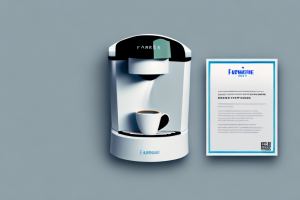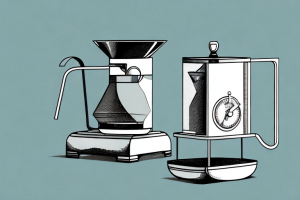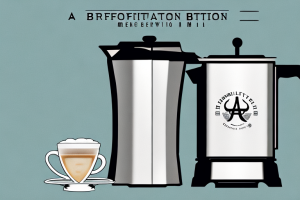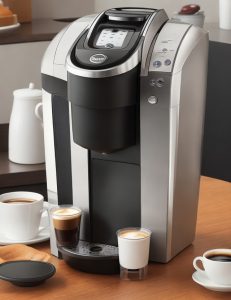Non-electric Coffee Maker

A traditional
Are you tired of relying on electricity to make your morning cup of coffee? Well, look no further than a non-electric coffee maker. Not only do these devices provide a delicious cup of joe, but they also offer a range of benefits and unique features. Here, we’ll guide you through the benefits of using a non-electric coffee maker, how to choose one that is right for your needs, the different types available, step-by-step instructions on how to make coffee with them, and much more.
The Benefits of Using a Non-electric Coffee Maker
Non-electric coffee makers have a multitude of advantages over their electric counterparts. For starters, they are an excellent choice for those who value sustainability and eco-friendliness. These devices work without requiring any electricity, which reduces your carbon footprint and saves money on your energy bill. Additionally, they are incredibly durable, and many models are built to last for years, meaning you won’t have to replace it frequently, which ultimately saves you money in the long run.
Another benefit of non-electric coffee makers is their portability. They are perfect for camping trips, outdoor adventures, or even for use in areas where electricity is not readily available. You can easily pack them in your backpack or car and enjoy a fresh cup of coffee wherever you go.
Non-electric coffee makers also offer a unique brewing experience. They allow you to slow down and enjoy the process of making coffee, as you have to manually heat the water and pour it over the coffee grounds. This can be a meditative and relaxing experience, and it allows you to appreciate the art of coffee-making in a new way.
How to Choose the Best Non-electric Coffee Maker for Your Needs
When shopping for a non-electric coffee maker, there are several factors to consider. Think about how many cups of coffee you drink every day, how much space you have in your kitchen, and if you plan on using it when camping or traveling. It’s also essential to think about the way you like your coffee. For instance, some non-electric coffee makers make espresso, while others make drip coffee. Knowing your preferences and needs will help you choose the perfect model.
Another important factor to consider when choosing a non-electric coffee maker is the material it’s made of. Some popular options include stainless steel, glass, and ceramic. Stainless steel is durable and easy to clean, while glass allows you to see the coffee as it brews. Ceramic is a great option for those who want a more traditional look and feel. Additionally, consider the maintenance required for each material. For example, glass and ceramic may be more fragile and require more careful handling. Ultimately, the material you choose will depend on your personal preferences and needs.
Different Types of Non-electric Coffee Makers and Their Features
Non-electric coffee makers come in several different types, including percolators, French presses, and stovetop espresso makers. Each type produces a unique coffee flavor that varies in intensity and strength. Percolators are a popular choice for those who love a robust and bold taste, while French presses make a milder and smoother coffee due to the lack of paper filters used. Stovetop espresso makers utilize pressure to create an authentic espresso flavor.
Another type of non-electric coffee maker is the Turkish coffee pot, also known as a cezve. This small, copper or brass pot is used to make a strong and rich coffee that is traditionally served with a sweet treat. The cezve is heated on a stove or hot plate and the coffee is brewed by boiling the finely ground coffee beans with water and sugar.
For those who enjoy camping or outdoor activities, there are also non-electric coffee makers designed for use in the wilderness. These portable coffee makers, such as the AeroPress or the pour-over cone, are lightweight and easy to pack. They allow you to enjoy a fresh cup of coffee even when you’re far from civilization.
How to Make Coffee with a Non-electric Coffee Maker: Step-by-Step Guide
Making coffee with a non-electric coffee maker can seem intimidating, but it’s relatively easy once you know the steps. For a drip coffee maker, start by heating water to the desired temperature, adding coffee grounds to the filter, and pouring the hot water over the coffee grounds. Allow the coffee to steep for a few minutes before pouring it into your mug. Espresso makers require a bit more technique, including filling the bottom chamber with water and the top chamber with coffee grounds, then heating it on a stovetop until it begins to boil.
One important thing to keep in mind when using a non-electric coffee maker is the grind size of your coffee beans. For drip coffee makers, a medium grind is recommended, while espresso makers require a fine grind. Using the wrong grind size can result in a weak or bitter cup of coffee. Experiment with different grind sizes to find the perfect balance for your taste buds.
Tips and Tricks for Brewing the Perfect Cup of Coffee with a Non-electric Coffee Maker
Brewing coffee with a non-electric coffee maker takes some practice, but there are several tips and tricks to help make the process smoother. Always use high-quality coffee beans to ensure a delicious flavor, and pay attention to the water-to-coffee ratio. Experiment with different grind sizes and brewing times to find your preferred taste. And don’t forget to preheat your coffee maker before adding the coffee grounds to ensure optimal flavor extraction.
Another important factor to consider when brewing coffee with a non-electric coffee maker is the temperature of the water. Water that is too hot can result in a bitter taste, while water that is too cold can lead to under-extraction. Aim for a water temperature between 195-205°F for optimal flavor extraction.
Additionally, the type of non-electric coffee maker you use can also affect the taste of your coffee. French presses, for example, produce a full-bodied and rich flavor, while pour-over coffee makers offer a cleaner taste. Experiment with different types of coffee makers to find the one that best suits your taste preferences.
Maintenance and Care Tips for Your Non-electric Coffee Maker
To ensure your non-electric coffee maker lasts for many years, it’s essential to take proper care of it. Cleaning and maintenance are critical, which means frequently washing the device, descaling it if necessary, and checking for any mechanical issues that may arise. Be sure to store your coffee maker in a dry and cool place when it’s not in use to prevent any accidental damage.
Another important aspect of caring for your non-electric coffee maker is to use high-quality coffee beans. Cheap or low-quality beans can leave behind residue and oils that can clog the device and affect the taste of your coffee. It’s also recommended to use filtered water to prevent any mineral buildup that can damage the coffee maker over time.
If you’re planning to take your non-electric coffee maker on a camping trip or outdoor adventure, it’s crucial to pack it carefully. Make sure to wrap it in a protective material, such as a towel or bubble wrap, to prevent any damage during transportation. Additionally, it’s a good idea to bring along extra filters and a small brush for cleaning the device while on the go.
Using Your Non-electric Coffee Maker in the Great Outdoors: Camping and Hiking Trips
If you love exploring the great outdoors, a non-electric coffee maker can be a game-changer. They are portable, lightweight, and easy to use, making them an excellent choice for any camping or hiking trip. Whether you choose a French press or stovetop espresso maker, you can enjoy your favorite coffee in the midst of nature.
One of the best things about using a non-electric coffee maker on your outdoor adventures is that you can enjoy a hot cup of coffee even when you’re far away from civilization. You don’t need to worry about finding an electrical outlet or bringing along batteries. All you need is your coffee maker, some coffee grounds, and hot water. Plus, many non-electric coffee makers are made from durable materials like stainless steel or glass, so they can withstand the wear and tear of being transported in a backpack or camping gear.
The Environmental Impact of Using a Non-electric Coffee Maker
Using a non-electric coffee maker can significantly impact the environment positively. These devices require no electricity, meaning they reduce your energy usage and carbon emissions. Additionally, many models come with reusable filters, eliminating the need for disposable paper filters that contribute to environmental waste.
Furthermore, non-electric coffee makers often have a longer lifespan than their electric counterparts, reducing the amount of waste produced from constantly replacing appliances. Additionally, using a non-electric coffee maker can encourage a more mindful and intentional approach to coffee consumption, as the process of making coffee becomes a deliberate and slower ritual rather than a quick and mindless task.
Comparing the Cost and Efficiency of Electric vs Non-Electric Coffee Makers
Non-electric coffee makers are considerably more affordable than their electric counterparts, making them an excellent choice if you’re on a tight budget. They also are more efficient, as they don’t require electricity, meaning they save on energy costs and may last longer than electric models.
However, electric coffee makers offer the convenience of being able to brew coffee quickly and easily, without the need for a stove or other heat source. They also often come with additional features, such as programmable timers and automatic shut-off, which can be useful for busy individuals who need their coffee fix on-the-go.
Another factor to consider when comparing electric and non-electric coffee makers is the environmental impact. Non-electric models are more eco-friendly, as they don’t require electricity and therefore don’t contribute to carbon emissions. However, electric models can be more sustainable if they are energy-efficient and made from recycled materials.
Alternative Uses for Your Non-electric Coffee Maker
Believe it or not, your non-electric coffee maker can do more than just make coffee. You can use it to heat water for tea or hot cocoa, or even make cold-brew coffee by steeping coffee grounds in cold water overnight. Get creative and see what else your coffee maker can do!
Another great use for your non-electric coffee maker is to make herbal infusions. Simply add your favorite herbs to the coffee filter and pour hot water over them. Let the herbs steep for a few minutes and then enjoy a delicious and healthy herbal tea.
If you’re a fan of camping or outdoor activities, your non-electric coffee maker can also come in handy. You can use it to boil water for cooking or to make hot drinks while you’re out in the wilderness. It’s a lightweight and portable option that can make your outdoor adventures even more enjoyable.
A Brief History of Non-Electric Coffee Makers
Non-electric coffee makers have a rich history that dates back centuries. The French press was first developed in the late 1800s and is still a popular choice today. Percolators were invented in the early 1900s and enjoyed popularity through the mid-20th century. And the stovetop espresso maker was created in Italy in the 1930s, providing an authentic espresso taste in the comfort of your home.
So, whether you’re an environmentally conscious coffee lover or an outdoor adventurer, a non-electric coffee maker is an excellent choice for brewing your perfect cup of coffee. With the right care and attention, non-electric coffee makers can provide you with a delicious and sustainable cup of joe for many years to come.
One of the benefits of using a non-electric coffee maker is that it allows you to have more control over the brewing process. With an electric coffee maker, the temperature and brewing time are often predetermined, but with a non-electric coffee maker, you can adjust these factors to your liking. This can result in a more personalized and flavorful cup of coffee that perfectly suits your taste preferences.



